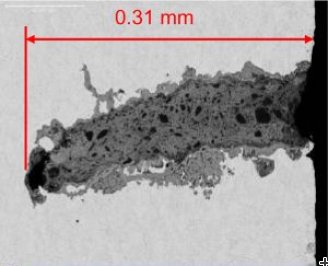Copyright 2012 neutronsources.org | All rights reserved. | Powered by FRM II | Imprint / Privacy Policy
Ensuring oil and gas pipeline integrity using neutron beams
Date: 27/09/2017
Source: cins.ca
The Canadian energy sector has developed standard practices to ensure that oil and gas pipelines remain safe as they age. For the past decade, these standard practices have been influenced by a team of researchers, including one University of Alberta professor and his industrial partners, who use neutron beams to better understand stress and corrosion in pipeline steel.
Despite an increasing focus on clean energy sources, much of today’s North American society continues to be fueled by oil and gas. Canadian energy companies use pipelines to reliably transport over 97 percent of the oil and gas produced in Canada. Pipelines are much better for the environment than the alternative methods for moving fuel—namely, by truck or train, both of which are more susceptible to accidents. Despite an excellent safety record, however, there is often a damaging financial and public relations impact whenever a pipeline leak occurs.
In recent decades, research has led to improved pipeline technologies, and nearly all pipe failures in Canada have occurred in lines that the industry describes as ‘vintage’ (i.e., those put in the ground before 1980). Some of these vintage pipelines are now over 70 years old, and decisions about how to manage the effects of ageing—including when to replace them—are critical not only to the economic bottom line, but also to the social bottom line.
Indeed, pipelines have been coming under increasing scrutiny from the public. Thus, it is critical for the pipeline industry to understand exactly how the materials behave as they age, and to have precise knowledge of the possible causes of failures, in order to maintain their social licence.
Some cracks in pipeline steel are driven by a combination of stress and corrosion—an occurrence known as ‘stress–corrosion cracking.’ While this type of cracking is most often linked to locations with corrosive groundwater (i.e. water that is basic, or high on the pH scale), this is not always the case. In one instance in Canada in the 1980s, a stress–corrosion crack developed in a pipeline situated in near-neutral groundwater conditions, where the pH of the groundwater was slightly acidic. (In this case, the low acidity was the result of organic materials dissolving into the groundwater and naturally releasing carbon dioxide.) This new type of cracking was termed ‘near-neutral pH stress–corrosion cracking.’
A drive to understand how this type of cracking could occur sparked much research in the 1990s; as a result, researchers discovered other characteristics of near-neutral pH stress–corrosion cracking, including differences in the manner and depth of crack propagation. Notably, they found that over 95 percent of these cracks automatically stopped growing before they reached one millimetre deep.
In 1999, the Canadian Energy Pipeline Association established a set of recommended practices for identifying and dealing with such cracks before they became a problem. However, it was clear that more research was needed to understand the underlying mechanisms behind this newly discovered form of cracking, particularly in terms of what might be driving a very small fraction (i.e., less than one percent) of these cracks to grow deep enough to pose more of a concern to a pipeline.
University of Alberta professor Weixing Chen took up the task of examining the role that stress plays in the formation and growth of near-neutral pH stress–corrosion cracks. With support from two corporate sponsors (i.e., TransCanada Pipelines and a company then known as Nova Research and Technology Corporation), Chen set out to reproduce the cracking under controlled yet realistic conditions with known stress levels. Helping with this research was Greg Van Boven, then a full-time engineer with Nova who began working under Chen as a part-time graduate student.
Chen and Van Boven started with a section of steel extracted from an actual pipeline, which they machined, bent, and cut into flat test plates to provide a fresh surface without any cracks or corrosion. These operations were also designed to produce a widely varying distribution of stress within the test plates so that the researchers could observe whether the different stress levels would have any effect on subsequent cracking.
The next step was to determine how much stress was present throughout the plates. To find out, in 2000, Van Boven came to the Canadian Neutron Beam Centre (CNBC), as neutron diffraction is the only non-destructive way to measure stress deep inside steel.
“Neutron diffraction was the only method we could have used to measure the stress,” says Chen. “X‑rays only give the stress at the surface, about 0.1 mm deep, but [in this case] we needed to know the stress at the end of the crack tips, 1 mm deep or deeper. Another common method, hole-drilling, is destructive and less accurate. It also doesn’t provide the complete picture and, like x‑rays, it’s depth-limited.” This non-destructive aspect was crucial to the research, as it allowed Van Boven to return to the CNBC for a series of follow-up experiments on the same test plates.
The initial stress measurements confirmed that the plates did indeed have a wide distribution of stress, including some areas where the stress was elevated above what is typically found in pipelines. This high stress ensured that the experiment represented the full range of possible conditions, including a worst-case scenario. The test plates were then brought to a Nova test facility and exposed to realistic forces (i.e., external pressures similar to what pipelines would be exposed to while in operation) to see how these forces might change the stress levels in the samples. Van Boven brought the test plates back to the CNBC and, using neutron beams, observed that the high-stress areas that had initially been present in the test plates were relieved somewhat after exposure to these realistic forces.
Van Boven then added the effect of low acidity to the experiment and extended the length of the tests to mimic both the natural acidity in the environment and the external forces that pipeline steel is exposed to due to changing fluid pressures—in other words, the conditions that an operating gas pipeline would actually experience over 20 years. As the test facility could accommodate only a few test plates at a time, and since each test took four months, the entire experiment took a number of years to complete.
Afterwards, Chen and Van Boven observed that a number of features had appeared on the surface of the test plates, including cracks and ‘micro-pits’ (i.e., small holes less than 0.2 mm deep that can occur when tiny flakes corrode off the metal’s surface), which the researchers then examined under optical and electron microscopes.
Notably, the researchers found that all the cracks in the test plates were located at the bottom of micro-pits; in turn, the occurrence of these micro-pits was highly correlated with the locations in the steel where the stress levels had been highest at the beginning of the tests. Furthermore, they found that the cracks always stopped growing when they reached an area of low stress.
Their observations were positive news for pipeline integrity for two reasons. First, they showed that high-stress areas are typically relieved somewhat by the in-service conditions that pipelines naturally experience. Second, they revealed that whenever there is high stress in the steel, nature produces counteracting stresses elsewhere in the metal (usually in close proximity); that’s why the cracks don’t propagate when the stress is high—because they quickly reach an area with counteracting stress.
Chen and Van Boven ultimately concluded that there is only a narrow range of conditions under which near-neutral pH stress–corrosion cracking poses a threat. They determined that it takes unusual conditions—namely, high (but not too high) stress over a large distance, or stress in rare combination with other factors—to cause this kind of crack to spread deep into the steel.
Their results, which were published in two papers in 2006 (DOI:10.1016/j.actamat.2006.08.037 ; DOI:10.1016/j.actamat.2006.07.021), had an immediate impact on the pipeline industry. For instance, they informed decision making about manufacturing methods and welding processes to ensure acceptable stress levels in pipeline steel. Furthermore, in 2007, the industry updated its guidelines for identifying and dealing with these cracks, and this research has continued to influence the current guidelines, published in 2015.
“The industry has been using standard practices informed by our research for over a decade now,” says Van Boven, who spent much of his subsequent career as a research engineer focused on pipeline integrity at Spectra Energy Transmission (acquired by Enbridge in 2017). “The research I performed as a graduate student was valuable for its impact on the industry. It was also a valuable launch into my current career,” he adds. “I learned to communicate effectively about technical aspects of stress, pipeline integrity, and risk evaluation, a skill I need to respond to questions from regulators, industry colleagues, and the public.”
Chen and Van Boven have continued their research collaboration to better understand stress–corrosion cracking in near-neutral pH environments under the sponsorship of the US Department of Transportation, the Pipeline Research Council International, TransCanada Pipeline Limited, Spectra Energy Transmission, Enbridge Pipeline, and the Natural Sciences and Engineering Research Council of Canada.
“Our goal is to reduce variability in pipeline integrity, which is increasingly important as our pipelines age,” says Van Boven.
One of their follow-up studies looked more closely at the role of the hydrogen generated by the corrosion process and how that hydrogen influences crack growth. Their findings, published in 2009 (doi:10.1016/j.actamat.2009.08.047), showed that when hydrogen is absorbed into the steel, it can enable cracks to grow deeper, thus confirming that it is one of the key factors explaining why a small fraction of near-neutral pH stress–corrosion cracks may pose a threat to pipeline integrity.
In a more recent study, Chen and Van Boven collaborated with TransCanada Pipelines and Enbridge to develop a computer model to predict the rate of crack growth under a wide range of stress and corrosion conditions. The model is based on their findings from earlier studies, including their neutron beam stress measurements. Their results, published in two papers in 2017 (DOI:10.1007/s11661-016-3951-3 ; DOI:10.1007/s11661-016-3939-z), showed that premature failures in the field (i.e., after only 20 or 30 years) due to stress–corrosion cracking in near-neutral pH environments are the result of worst-case conditions rather than common conditions.
Notably, their models are a great improvement over previous models in terms of their ability to make accurate predictions about pipeline lifetimes. The computer models developed by Chen, Van Boven, and their collaborators are now being used by others in the industry—including engineers from member companies of the Pipeline Research Council International—to account for corrosion, stress, and hydrogen in their own research efforts to more accurately determine when pipelines need to be replaced or undergo maintenance that will ensure continued safe and spill-free operations.

